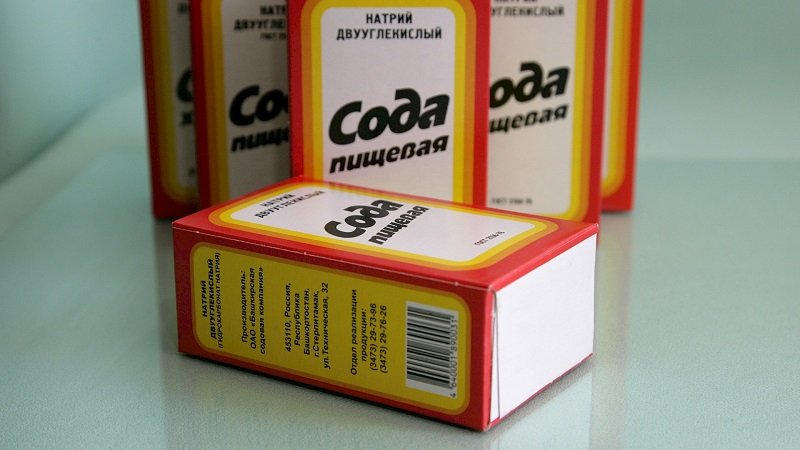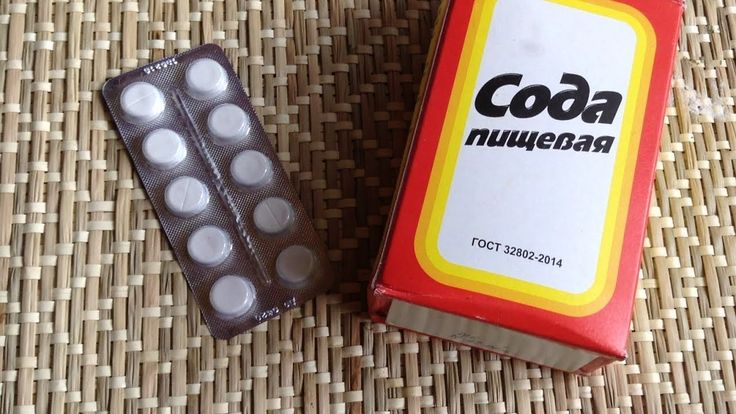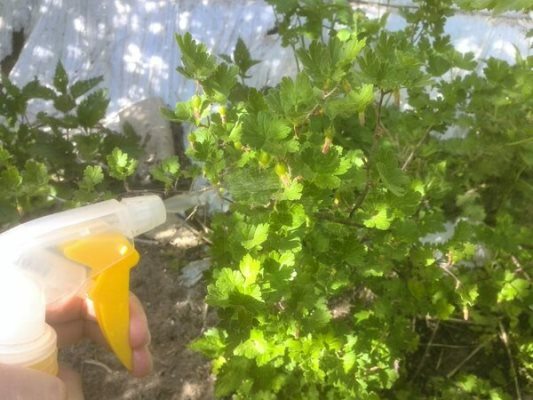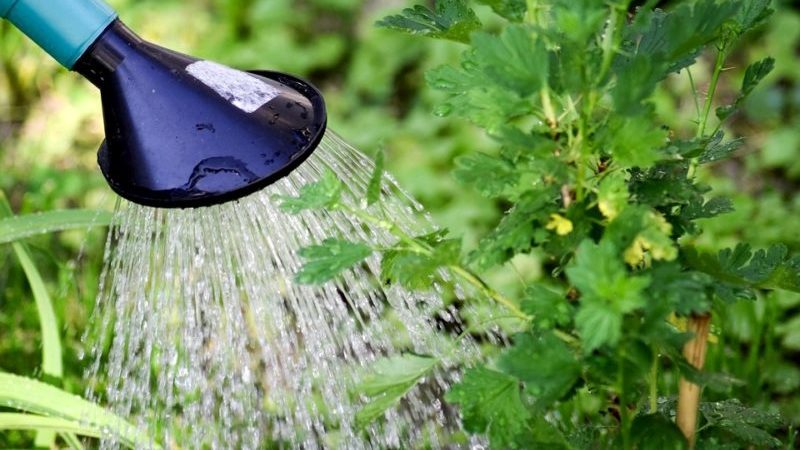How to properly use powdery mildew soda on gooseberries: recipes and processing recommendations
High humidity and high air temperature favor the appearance of one of the most common and dangerous diseases on gooseberries called powdery mildew. It is characterized by a light bloom with droplets of liquid on foliage and shoots. If the plant is left untreated, the fungus affects all branches, the fruits crack and rot. In this article we will tell you how to get rid of powdery mildew on gooseberries using baking soda.
The content of the article
Why use baking soda against powdery mildew on gooseberries

Gooseberry is the berry most susceptible to defeat by powdery mildew. There are many ways to get rid of the disease, but before buying expensive and unhealthy chemicals, we advise you to try a time-tested, inexpensive and affordable home-made remedy.
Plain baking soda, which is in every home, will help to cope with this fungal disease. Another plus a folk remedy - the possibility of its use in the summer, when the berries are already ripe, while the use of chemicals can destroy crops and harm the human body.
The principle of action of the tool
Baking soda is the simplest soft alkali, and such an environment is detrimental to the pathogens of powdery mildew.Soda is a versatile, natural and inexpensive remedy for fighting many plant diseases, available to everyone.
Important! To maintain the healing effect of baking soda, do not use metal and dirty dishes, do not heat above + 55 ° C. The solution is used within 3 hours after preparation, otherwise the beneficial effect will decrease. For processing, you may need a sprayer with a sprayer.
What soda to use
For powdery mildew, both baking soda (kitchen) and soda ash (baking soda) are used. The latter is 2 times stronger than food.
Food
Sodium bicarbonate (the scientific name for baking soda) is an alkali that practically does not affect plant tissues and does not injure them.
The simplest remedy for powdery mildew is a soda solution. Experienced gardeners get rid of white bloom in 2-3 treatments.

Calcined
Soda ash began to be calcined back in the 19th century. The result is a substance that is not suitable for human consumption, but is widely used in the household.
Soda ash solutions can be used to treat bushes before flowering.
How to prepare the product
Experienced gardeners observe the following proportions:
- Take 4 liters of water, dissolve 1 tbsp. l. baking soda and 1 tsp. liquid soap. The bushes are processed 2-3 times in 7-8 days.
- For 5 liters of water, take 25 g of soda ash and 5 g of soap. It is recommended to process the bushes with a cold solution 3 times every 10 days.
The addition of soap or other detergent is necessary so that the solution does not drip from the leaves and branches like rainwater, but sticks to the shoots for a stronger and more lasting effect.
Recipes
There are many baking soda recipes to combat powdery mildew.
Baking soda + soap
You need to take:
- baking soda - 4 tbsp. l .;
- liquid soap - 2 tbsp. l .;
- water - 10 liters.
Soda and soap are dissolved in water.This solution is used to process gooseberries every 5-7 days. This composition is suitable for the prevention of diseases of all horticultural and horticultural crops.
Soda + aspirin

Ingredients:
- baking soda - 1 tbsp. l .;
- aspirin - 1 tab.;
- any detergent - 1 tsp;
- vegetable oil - 1 tbsp. l .;
- water - 5 l.
All components are thoroughly mixed. The solution is used to treat affected plants once every 2 weeks throughout the season.
Soda + iodine
There is another good composition for getting rid of not only ash (powdery mildew), but also aphids.
To prepare it, take:
- soda - 2 tbsp. l .;
- iodine - 10 ml;
- liquid soap or other detergent - 2 tbsp. l .;
- water - 10 liters.
All components are mixed and diluted with water. The bushes are treated with a freshly prepared solution.
Soda ash + soap
Composition:
- 50 g of soda ash;
- 10 liters of water;
- 10 ml liquid detergent.
Soda must be poured into 1 tbsp. boiling water, dilute to obtain a volume of 10 liters. Pour 10 ml of liquid soap there. Bushes are processed 2 times - before and after flowering.
Important! Although baking soda is considered safe for plants, overdose should be avoided. Excess can slow down the development of greenery.
How to properly handle gooseberries

Processing rules:
- Tear off infected leaves and peduncles (yellow and devoid of turgor).
- Having found powdery mildew on the bushes during the flowering period, it is necessary to cut off the crown and clear the bush of diseased areas. It is necessary to remove infected branches and leaves as much as possible so that the disease does not spread to the rest of the bush. This increases the chances of recovery.
- The upper areas of the gooseberry soil are removed from the garden plot to avoid re-infection.
- Then the plant is sprayed with a soda solution. For the first time, the bushes are treated in early spring - before sap flow and bud break. This is done again at the beginning of flowering. Plants are processed in dry, calm weather. First you need to spray the top of the gooseberry bush, then the side and bottom. It is necessary that the solution gets on all shoots and foliage. You can pour the healing solution into a large basin and immerse the branches of the plant there.
- They also water the land under the bushes to destroy the remnants of spores after replacing the topsoil.
When soda powder, metal or plastic interacts, sometimes harmful chemical reactions occur, therefore it is recommended to use only glassware or enamel-coated glassware to prepare the solution.
Read also:
Can i water gooseberries with baking soda?
During the fruiting period, the use of chemicals is undesirable. Therefore, to treat gooseberries from powdery mildew, you can use safe solutions of soda ash or baking soda.

Precautions
When processing affected gooseberry bushes, it is important to follow simple rules:
- Wear gloves to protect your hands from irritation.
- While preparing the solution, it is not recommended to tilt your head over it. Use a mask or a variety of respirators to avoid inhalation of the ingredients and the occurrence of allergic reactions.
- Keep children and animals away from the container with the solution and preparations. If fluid enters the mouth or stomach, flush immediately. If allergic reactions occur, medical attention is needed, otherwise swelling of the respiratory tract may occur.
- Rinse your face and hands with plenty of cold water after completing all work, and at the first sign of poisoning or burns. Call an ambulance immediately if necessary.
Effectiveness in comparison with other methods
Processing gooseberry bushes with solutions with soda is one of the most effective and safe methods of dealing with powdery mildew. If you start treatment when the plant is 30% infected, you can get rid of the disease in 2-3 weeks.
The main condition for success is the regularity of procedures and timely prevention of fungal disease, which can not only deprive the entire crop, but also spread to other crops.
Preventive measures
Preventive measures will prevent the development of the disease:
- Shrubs are planted at a distance of 1.5 m in well-lit areas, since the fungus does not tolerate sunlight and heat.
- Gooseberries are systematically thinned out, injured, dead and diseased branches are regularly cut off.
- Fallen leaves are removed to avoid the spread of fungal diseases.
- Plants are treated with a soda solution (2 tablespoons per 8-10 liters of water).
- The soil is loosened next to the bushes, the branches are cut or lifted with the help of various devices so that they do not come into contact with the ground.
- It is undesirable to use manure as fertilizer due to the threat of containing fungal spores in it.
- Mineral dressings with a minimum nitrogen content are used. A trace element makes gooseberries more susceptible to fungal diseases.
At the first visible signs of the disease, diseased branches and leaves must be removed. This prevents the development of fungal infection and contamination of other crops. The removed branches are burned, while observing fire safety measures.
Read also:
Conclusion
To protect the gooseberries from powdery mildew, prevention is started in the spring. The minimum actions are reduced to digging the site and sanitary pruning of bushes.
In the presence of the first signs of the disease, the plants are treated with a solution of baking soda or soda ash with the addition of soap, iodine or aspirin. This safe and inexpensive remedy will get rid of powdery mildew in 2-3 weeks.